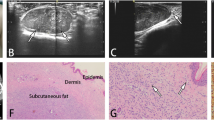Abstract
Objectives
Dermatofibrosarcoma protuberans (DFSP) is an intermediate-grade tumour which may undergo fibrosarcomatous transformation to a high-grade sarcoma (DFSP-FST). DFSP-FST requires wide local resection, and therefore, pre-operative identification is important. The aims of this study are to see if DFSP and DFSP-FST can be differentiated based on MRI appearances, and to determine the ability of ultrasound-guided core needle biopsy (US-CNB) to identify DFSP-FST.
Materials and methods
Retrospective review of patients with a histological diagnosis of DFSP with/without transformation to DFSP-FST. Patient age, gender, lesion location and maximal size were recorded, as were several MRI features. MRI studies were reviewed independently by 2 musculoskeletal radiologists and the assessed features were then compared with final surgical resection histology. Histological results of US-CNB were also compared with final surgical pathology.
Results
A total of 42 patients were included, 26 males and 16 females with a mean age of 41.3 years (range 3–78 years). The upper limb was involved in 12 cases, the lower limb in 17 and the trunk in 13. Final surgical histological diagnosis was DFSP in 21 (50%) cases and DFSP-FST in 21 (50%) cases. Mean tumour dimension for DFSP was 32 mm and DFSP-FST 68 mm (p < 0.001). MRI features indicative of DFSP-FST included multi-lobular morphology (p = 0.03), T2W hypointensity compared with fat (p = 0.03), internal flow voids (p = 0.03) and peri-tumoral oedema (p < 0.001). Only 3 cases of DFSP-FST were correctly diagnosed on US-CNB.
Conclusions
Various MRI findings can suggest a diagnosis of DFSP-FST, but US-CNB is unreliable at identifying high-grade fibrosarcomatous transformation.








Similar content being viewed by others
References
Llombart B, Serra-Guillén C, Monteagudo C, López Guerrero JA, Sanmartín O. Dermatofibrosarcoma protuberans: a comprehensive review and update on diagnosis and management. Semin Diagn Pathol. 2013;30:13–28.
Allen A, Ahn C, Sangüeza OP. Dermatofibrosarcoma protuberans. Dermatol Clin 2019;37:483–488.
Kransdorf MJ. Malignant soft-tissue tumors in a large referral population: distribution of diagnoses by age, sex, and location. AJR Am J Roentgenol 1995;164:129–134.
Weinstein JM, Drolet BA, Esterly NB, Rogers M, Bauer BS, Wagner AM, et al. Congenital dermatofibrosarcoma protuberans: variability in presentation. Arch Dermatol. 2003;139:207–11.
Kornik RI, Muchard LK, Teng JM. Dermatofibrosarcoma protuberans in children: an update on the diagnosis and treatment. Pediatr Dermatol. 2012;29:707–13.
Liang CA, Jambusaria-Pahlajani A, Karia PS, Elenitsas R, Zhang PD, Schmults CD. A systematic review of outcome data for dermatofibrosarcoma protuberans with and without fibrosarcomatous change. J Am Acad Dermatol. 2014;71:781–6.
Voth H, Landsberg J, Hinz T, Wenzel J, Bieber T, Reinhard G, et al. Management of dermatofibrosarcoma protuberans with fibrosarcomatous transformation: an evidence-based review of the literature. J Eur Acad Dermatol Venereol. 2011;25:1385–91.
Al Barwani AS, Taif S, Al Mazrouai RA, Al Muzahmi KS, Alrawi A. Dermatofibrosarcoma protuberans: insights into a rare soft tissue tumor. J Clin Imaging Sci. 2016;6:16.
Kransdorf MJ, Meis-Kindblom JM. Dermatofibrosarcoma protuberans: radiologic appearance. AJR Am J Roentgenol. 1994;163:391–4.
Torreggiani WC, Al-Ismail K, Munk PL, Nicolaou S, O’Connell JX, Knowling MA. Dermatofibrosarcoma protuberans: MR imaging features. AJR Am J Roentgenol. 2002;178:989–93.
Zhang L, Liu Q, Cao Y, Zhong J, Zhang W. Dermatofibrosarcoma protuberans: computed tomography and magnetic resonance imaging findings. Medicine (Baltimore). 2015;94:e1001.
Bergin P, Rezaei S, Lau Q, Coucher J. Dermatofibrosarcoma protuberans, magnetic resonance imaging and pathological correlation. Australas Radiol. 2007;51 Spec No.:B64–66.
Thornton SL, Reid J, Papay FA, Vidimos AT. Childhood dermatofibrosarcoma protuberans: role of preoperative imaging. J Am Acad Dermatol. 2005;53:76–83.
Serra-Guillén C, Sanmartín O, Llombart B, Nagore E, Deltoro C, Martín I, et al. Correlation between preoperative magnetic resonance imaging and surgical margins with modified Mohs for dermatofibrosarcoma protuberans. Dermatol Surg. 2011;37:1638–45.
Hakozaki M, Yamada H, Hasegawa O, Watanabe K, Konno S. Radiologic-pathologic correlations of fibrosarcomatous dermatofibrosarcoma protuberans with various histological features on enhanced MRI and PET/MRI. Clin Nucl Med 2016;41:241–243.
Mentzel T, Schärer L, Kazakov DV, Michal M. Myxoid dermatofibrosarcoma protuberans: clinicopathologic, immunohistochemical, and molecular analysis of eight cases. Am J Dermatopathol. 2007;29:443–8.
Jha P, Moosavi C, Fanburg-Smith JC. Giant cell fibroblastoma: an update and addition of 86 new cases from the Armed Forces Institute of Pathology, in honor of Dr. Franz M Enzinger Ann Diagn Pathol 2007;11:81–88.
Goldblum J, Weiss S, Folpe A. Enzinger and Weiss’s soft tissue tumours. 7th ed. Elsevier; 2019.
Trojani M, Contesso G, Coindre JM, Rouesse J, Bui NB, de Mascarel A, et al. Soft-tissue sarcomas of adults; study of pathological prognostic variables and definition of a histopathological grading system. Int J Cancer. 1984;33:37–42.
Colletti SM, Tranesh GA, Whetsell CR, Chambers LN, Nassar A. High diagnostic accuracy of core needle biopsy of soft tissue tumors: an institutional experience. Diagn Cytopathol. 2016;44:291–8.
Rohela H, Lee C, Yoo HJ, Kim H-S, Kim Y, Cho HS, et al. Comparison of the diagnostic performances of core needle biopsy in myxoid versus non-myxoid tumors. Eur J Surg Oncol. 2019;45:1293–8.
Tan A, Rajakulasingam R, Saifuddin A. Diagnostic concordance between ultrasound-guided core needle biopsy and surgical resection specimens for histological grading of extremity and trunk soft tissue sarcoma. Skeletal Radiol. 2020
Chhabra A, Ashikyan O, Slepicka C, Dettori N, Hwang H, Callan A, et al. Conventional MR and diffusion-weighted imaging of musculoskeletal soft tissue malignancy: correlation with histologic grading. Eur Radiol. 2019;29:4485–94.
Acknowledgments
The authors would like to acknowledge Mr. Paul Bassett for statistical input.
Author information
Authors and Affiliations
Corresponding author
Ethics declarations
Conflict of interest
The authors declare that they have no conflict of interest.
Additional information
Publisher’s note
Springer Nature remains neutral with regard to jurisdictional claims in published maps and institutional affiliations.
Rights and permissions
About this article
Cite this article
Choong, P., Lindsay, D., Khoo, M. et al. Dermatofibrosarcoma protuberans: the diagnosis of high-grade fibrosarcomatous transformation. Skeletal Radiol 50, 789–799 (2021). https://doi.org/10.1007/s00256-020-03617-3
Received:
Revised:
Accepted:
Published:
Issue Date:
DOI: https://doi.org/10.1007/s00256-020-03617-3




